![]() The Pacific War Online Encyclopedia
The Pacific War Online Encyclopedia
|
| Previous: Tank Destroyers | Table of Contents | Next: Tao Kuang |

U.S. Army. Via ibiblio.org
A tank is an armored vehicle armed with cannon and machine guns. It usually moves on continuous tracks, also known as caterpillar treads, which give it considerable cross country mobility, and its main armament is usually mounted in a revolving turret allowing the main armament to be traversed to bear on any direction. These features distinguish tanks from armored cars, which move on conventional tires, and self-propelled guns, whose main armament is mounted in the front of the vehicle hull where it has a limited arc of fire. Originally invented by the British during the First World War to break the stalemate on the Western Front, and championed by Winston Churchill, tanks provided mobile firepower that could stand up to artillery barrage and help the infantry break through trench defenses. Tanks played a crucial role in both the First and the Second World War.
By the time war broke out in Europe in 1939, the Germans had organized most of their tanks into armored divisions, and these were supplied with mechanized infantry, which proved essential for overcoming local resistance to permit the tanks to continue advancing. These massed tank tactics were applicable on mainland Asia and on some of the larger islands of the Pacific, such as Luzon, that had large areas of flat ground. However, most of the Pacific battles were fought on small or rugged islands where tank mobility was either negated or irrelevant. Here tanks fell back into the direct infantry support role, providing cover and firepower for the infantry advance. The infantry, in turn, protected the tanks from enemy infantry equipped with shaped charges or other antitank weapons. Allied tanks proved crucial for neutralizing Japanese fortifications.
Even when employed in the direct infantry role, tanks were best used in small groups rather than individually. British tank commanders in Burma, who were usually relatively junior officers,
complained bitterly at the tendency of more senior infantry officers to
deploy the tanks in "penny packets" that dissipated their strength and
led to heavy casualties without ensuring victory.
One British tank officer recalled that "It took some time for it to
sink in that a troop of three was the minimum tank team, if we were not
to get too many knocked out. A single tank cannot cover itself while it
maneuvers, nor tow itself out of action. We on the other hand fully
realized that if we could save infantry lives by sacrificing machines
and crews, it was our job to do so. All we asked was that it was on a
really worthwhile task" (Allen 1984).
Early in the war, tanks and infantry experienced considerable difficulty coordinating their efforts. Once they were buttoned up in their tanks, the tank crews were restricted to viewing the outside world through vision slits or periscopes that gave a very limited field of view. The infantry had a clear view of the battlefield, but the problem was to communicate this information to the tank crews. The most primitive means of communication was for an infantryman to climb on top of the tank to communicate with its commander through his opened hatch. This was unhealthy for all concerned. Infantry could also designate targets using smoke grenades. Later on, telephones were attached to the rear of tanks, allowing an infantryman taking cover behind a tank to communicate with the tank commander without either man unduly exposing himself. Tanks so equipped were used in the Marshalls campaign, but many of the phones were shorted out by seawater during the landings, forcing the troops to go back to the old, hazardous means of communication.
The armored fist of a tank force is supported by a vulnerable logistical tail. No less an authority than the German master of armored forces, Heinz Guderian, said that "Logistics is the ball and chain of armored warfare" (Roberts 2011). American tank forces fighting on islands such as Tinian sometimes found that not enough trucks had been brought ashore to permit rapid resupply of ammunition and fuel. In other situations, enemy fire prevented soft-skinned vehicles from bringing up the supplies. In some cases this meant that part of a tank force had to be devoted to transporting the supplies. Tanks were sometimes also used as armored ambulances to evacuate casualties from areas under heavy enemy fire.
Tanks consume fuel prodigiously. The Sherman M4 tank, which was not
particularly inefficient for a tank, had a highway fuel efficiency of
not quite a mile per gallon of gasoline. This gave it a maximum range of a little over 150 miles (240 km). In combat operations, a tank typically
spent much of its time stationary or moving slowly, which reduced the
range still further. A tank crew often faced a dilemma between shutting
down the engine when not in motion, to conserve its fuel supply, and
leaving the engine running, to ensure the tank could move quickly when
it needed to. Most crews erred on the side of leaving the engine
running.
Tank treads have only a limited lifetime, being subject to
considerable wear and tear even on good roads. In the Pacific, tanks
typically entered combat directly from a landing ship or from a port close to the combat zone, but the British in Burma used tank transports to reduce tread wear on tanks being delivered from Imphal to the combat zone in central Burma in early 1945. The
tank transporters also reduced damage to roads from the tank treads and
were typically faster and more fuel efficient than the tanks themselves.
Japanese Tanks. The Japanese
did not begin mass production of their first tank model, the Type 89B,
until 1934, and Japanese tank development continued to lag behind that
of her future enemies. Given Japan's limited industrial base, the Army had to choose between emphasizing aircraft or armor, and it chose to emphasize aircraft. Japanese
tank doctrine assumed that any tank battle would take place in
China
or northeast Asia, where there were few good roads or bridges capable
of
bearing heavy loads. Japan's narrow-gauge rail system was not suitable
for transporting large tanks, and Japanese tanks would also have to be
small enough for transport overseas to the battlefield. As a result,
Japanese armored forces were initially limited to 10-ton light tanks or
15-ton medium tanks. Because of the limitations of
Japanese industry, Japanese tanks tended in any case to be thinly
armored,
mechanically unreliable, and undergunned. They did not carry guns
as large as 3" (75mm) until late in the Pacific War. Production
was just 28 tanks per
month of all types as late as 1939. However, the Japanese pioneered the
use of diesel engines in tanks, which were much less prone to catching
fire than gasoline engines.
In 1937 the Japanese Army organized 1 Independent Mixed Brigade as an experimental combined-arms formation with a large tank component. However, Tojo farmed out the tanks widely as infantry support during the 1937 Chahar Expedition and was criticized by the brigade commander, who was subsequently dismissed for insubordination. The tanks were reorganized into 1 Tank Group, a pure armored formation whose tanks continued to be attached to infantry units for combat operations. As a result, the Japanese again made poor use of their armor at Nomonhan in 1939. The Japanese belatedly reconsidered their doctrine after the German panzers swept across Europe, and in April 1941 armor replaced cavalry as a principal branch of the Japanese Army. However, there was no time for new organization to be fully in place and new doctrine absorbed before war broke out in the Pacific.
Under the new doctrine, tank battalions were reorganized into regiments which, by late 1941, consisted of a light tank company, three medium tank companies, and supporting elements. A light tank company had thirteen light tanks while a medium tank company had two light tanks and ten medium tanks. Total manpower was usually less than 1000 men, so these regiments remained battalion-sized. Like most of the armies of the time, the Japanese eventually settled on a tank platoon of three tanks, with the two light and one of the medium tanks of each medium company forming the headquarters platoon. The tank regiment also had a large allotment of trucks and other vehicles, though these were usually a hodgepodge of types, adding to maintenance and supply difficulties. By 1945 the tank regiments had an authorized strength of two medium tank companies, two gun tank companies, a self-propelled gun company, and an infantry company riding in armored personnel carriers, for a total manpower of 1200 men. Cavalry reconnaissance regiments were gradually replaced with armored reconnaissance regiments of two motorized infantry companies (200 men each) and two tankette companies of eight tankettes each.
Tank regiments were organized into tank groups for administrative purposes, but these were converted to tank divisions in 1942. A total of four tank divisions were eventually activated, plus twelve independent tank companies. Additional companies of light tanks or tankettes were attached to a number of infantry divisions. The Japanese also raised nine independent tank brigades, with no artillery or infantry, as shock forces to work with infantry divisions. Two went to Manchuria and the rest were retained in the Home Islands.
The Japanese Navy equipped its Special Naval Landing Forces with a small number of Type 95 light tanks. The Navy also developed an amphibious tank, the Type 2 Ka-Mi.
The only Japanese tanks equipped with radios in 1941 were the
command tanks of platoons, companies, and regiments. The Japanese made
the decision to equip all tanks with radios in 1943, but the supply was
inadequate to demand and the majority of tanks continued to operate
without radios. The platoon leader signaled movement by hand
gestures, flags, or by simply requiring the other tanks in the platoon
to conform to his movements.
The
Japanese
made use of tanks in Malaya and in
both Philippine
campaigns. In Malaya, tanks were employed against British
formations that lacked their own armor support, were not trained in
antitank
methods, and were not adequately equipped with antitank weapons. Tanks
were very effective in this campaign, proving decisive at the Battle of the Slim River,
when a Japanese night attack with tank support surprised the British
and captured the crucial bridge across the river. In the
Philippines, the
Japanese tanks were neutralized by superior American
tanks, though Japanese air and infantry superiority carried the day. The Japanese landed light tanks at Milne Bay, where they quickly
bogged down and had to be abandoned, and the small number of Japanese tanks landed on Guadalcanal were annihilated by American 37mm antitank guns at the Battle of the Matanikau River.
At Iwo Jima, most of the tanks of 26 Tank Regiment were buried up to their turrets in
the soft volcanic ash, becoming steel pillboxes. This made them more
difficult targets but sacrificed their mobility. Since the battle was
characterized by positional warfare with little room for maneuver, this
doubtless seemed like a reasonable trade off to the Japanese. However,
five of the tanks were heavily camouflaged rather than buried and retained their mobility; when they broke cover, they were quickly eliminated by bazooka and flamethrower teams.
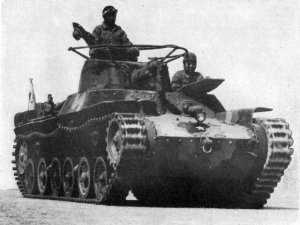
Japanese
Type 97 Tank
U.S. Army. Via ibiblio.org
The standard Japanese medium tank was the Type 97 Chi-Ha, a 15-ton tank which entered service in
1937. Its maximum armor protection was only 25mm, it was armed with
a 57mm cannon and bow and rear turret 7.7mm machine guns, and it had a maximum speed of 24 miles per hour (39
km/h). This
tank saw service both in Malaya and at Saipan.
The Type
97 Improved, which entered mass production in 1943, had a
higher-velocity 47mm gun whose armor-piercing round could penetrate
70mm of armor. A total of 1162 of all models were produced.
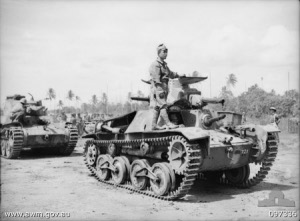
Japanese Type 95 Tank
Australian War Memorial. Via Wikimedia
Commons
The Type 97
was usually
supported by the Type 95 Kyu-go
light tank, which had a maximum of 12mm
of armor, a 37mm gun, a 6.5mm bow machine gun, and a maximum speed of 28 miles per hour (45 km/h).
This tank
had very poor visibility, and a number were destroyed with mass bazooka
fire on Saipan when they stumbled into the American perimeter. It did
not help that the turret had room only for the tank commander, who was
overtasked trying to simultaneously command the tank and man the turret
gun. The Type 97 was so lightly armored that American tanks armed with
75mm guns were
forced to use quick-fused high explosive
shells against them:
Armor-piercing rounds, and even ordinary high explosive shells, simply
passed through the tank without exploding. American heavy machine guns were capable of penetrating the armor at close range.
Japanese tankers in Burma improvised additional protection for a few of their command Type 95 tanks by bolting sheets of armor from captured American M3 tanks to the front of the tanks. According to Rottman and Takizawa (2008), the Japanese Army forbade the tankers to weld the extra armor directly to the tank, on the grounds that this was illegal alteration of government property. Instead, the extra armor was bolted to the tanks with a considerable air gap, which ironically provided the tanks with spaced armor protection that was better than if the armor had been directly applied.
A total of 2300 were produced.
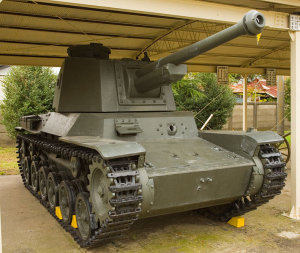
Japanese Type 3 Tank
Had the Allies invaded Honshu, they would have encountered the Chi-nu or Type 3, which had 50mm armor and was armed with a high-velocity 75mm gun (capable of penetrating 90mm of armor) and a 7.7mm bow machine gun. The Japanese intended to equip the two gun tank companies in each armored division with Type 3 tanks, but only about 60 were produced. In spite of its heavier armor and armament, the Type 3 was still no match for the best Allied tanks.
The Type 1 Ho-ni was a Type 97 Chi-ha chassis with the turret replaced by a shielded 75mm field gun or 105mm howitzer. The Type 1 was designed to provide mobile long-range artillery support, and its open sides and rear and lack of any machine gun made it very vulnerable in close combat. The Japanese intended to equip the self-propelled gun company in each armor division with the Type 1, but only 26 of the 75mm gun model and 54 of the 105mm howitzer model were produced.
The Japanese were fond of tankettes and produced them in relatively
large numbers. The Type 94 TK tankette was designed primarily as an
armored supply transporter, but the shortage of tanks meant that it was
employed frequently in combat, in China and elsewhere, and it was
supplied to reconnaissance regiments and divisional tank companies. The
Type 94 weighed 3.5 tons, had up to 12mm of armor, was armed with a
single 7.7mm turret machine gun, and had a maximum speed of 25 mph (40
km/h). A total of 823 were produced.
The Type 94 was being replaced with the Type 97 tankette when
war broke out in the Pacific. This tankette weighed 4.2 tons, had up to
16mm of armor, was armed with a 37mm gun, and could make 25 mph (40
km/h). A total of 616 were produced.
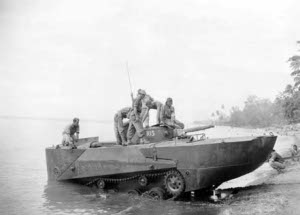
Japanese Type 2 Tank
The Type 2 Ka-mi was a light amphibious tank developed from the Type 95 by the Japanese Navy. It was encountered in some numbers at Saipan.
At the time of the surrender, the Japanese had begun production of the Chi-ri or Type 5 tank, with a 75mm turret gun and 37mm bow gun. Its maximum armor was 3" (76mm) and it could make 28 mph. The pinnacle of Japanese tank design, it was comparable with the American Sherman tank.
American Tanks. The
Americans
began production of their own tanks during the First World
War, but the Tank Corps was abolished in 1920 and all tanks were reassigned to
the infantry. The notion that tanks were useful only for infantry support
remained deeply entrenched until the German defeat of France in 1940. Like other powers, the Americans
were impressed with the German blitzkrieg successes and began to revise their
doctrine accordingly. The most distinctive feature of the new American armor
doctrine was the split between the roles of tanks, which would exploit penetrations of enemy lines, and tank destroyers,
meant
to contain any enemy armored breakthrough. In practice, this
meant that the Americans adopted a tank design that was easily
produced, mechanically reliable, and mobile, but was only moderately
well armored and whose armament was optimized for delivery of high
explosive
shells rather than high-velocity antitank rounds. Most American tanks
also used gasoline engines, and they acquired a well-deserved
reputation as fire traps.
American armored divisions adopted a novel organization that emphasized flexibility. By 1943, an American armored division was assigned three tank battalions, three armored infantry battalions, three armored artillery battalions, and supporting elements. However, the battalions were not organized into regiments or brigades. Instead, the division contained three headquarters, designated Combat Command A, Combat Command B, and Combat Command R, to which the infantry and tank battalions were assigned as needed for particular tasks, with CCA and CCB carrying out combat missions while CCR controlled battalions that had been pulled off the line to rest and refit.
A tank battalion contained one light and three medium tank companies, for a total of 17 light and 53 medium tanks; 13 halftracks; 64 trucks; and about 750 men. An armored infantry battalion likewise had an ample allotment of halftracks and trucks, while an armored artillery battalion had 18 self-propelled guns.
In addition to armored divisions, the Americans organized a large number of independent tank battalions. Many of these were attached to infantry divisions, where they quickly reverted to the role of infantry support. The Marines formalized this structure by including a tank battalion in the Marine division TO&E. In the Pacific, where no armored divisions were deployed prior to the planned invasion of Japan, the Army's independent tank battalions and the Marine divisional tank battalions were the principal armored units employed by U.S. forces.
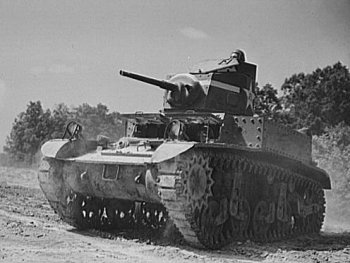
M3 Stuart Tank
Wikimedia
Commons
America
began the war with the M3 Stuart light
tank, which with a 37mm gun, 44.5mm of armor, and a maximum speed of 36
miles per hour was superior to its
Japanese counterpart. Japanese tankers in Burma had considerable
difficulty dealing with the Stuart, and carried out experiments with a
captured M3 that demonstrated that the armor-piercing round of the Type
95
could not penetrate the Stuart's armor from any direction at any range.
Multiple hits by high explosive rounds against the same point on the
tank were able to crack the armor, but not penetrate the interior. The
Japanese came to rely on ambushing
American tanks, firing multiple rounds from close range at vision
slits, turrets rings, tracks, and other vulnerable points in hopes of
knocking out the American tanks before they were themselves
annihilated. This was not often successful.
The Stuart was used to effect in the first Philippines
campaign and against
Japanese infantry in the South Pacific. The 37mm gun came with a
canister round that acted like a giant shotgun, capable of mowing down
infantry and stripping cover from fortifications.
The 37mm round fired by the Stuart was too light
to inflict serious damage on Japanese bunkers. One veteran said it
couldn't take the bark off a tree. The U.S. Army improvised a source of
heavier firepower in the form of the M3 SPM, a halftrack carrying a
75mm gun that was used both as a tank
destroyer and as a support weapon for the infantry. It was very
thinly armored and its crew badly exposed when firing the weapon. A
handful made it to Luzon by the time war broke out, and more were
employed in the South Pacific through 1943.
The Marines equipped a number of M3s with flamethrowers, starting with
the Saipan campaign. The flamethrower was
mounted in a steel tube that replaced the 37mm gun while retaining the
coaxial 0.30 machine gun. The flamethrower was a Canadian Ronson with a
range of about 60 to 80 yards (55m to 73m) and the crew was reduced to
a driver and a commander/gunner. Because of the way the flamethrower
was connected to the fuel supply, the turret had limited traverse,
which left the tank vulnerable to infantry attack. This was addressed
by assigning a regular gun tank to escort each "Satan" tank.
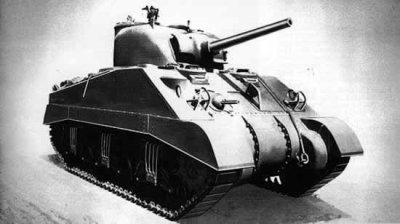
M4 Sherman Tank
The Americans later employed the M4 Sherman tank
in the infantry support role, where its
maximum 3" (76mm) of armor, 75mm gun (capable of penetrating 77mm of armor), and speed of 26 miles per
hour proved
effective once tank/infantry
cooperation was mastered. The Marines preferred the M4A2
model,
which ran on diesel fuel that was relatively easy to procure through
the Navy's logistics system. The
Sherman had a gyrostabilizer system that theoretically allowed the tank
to deliver aimed fire while on the move, but the system was complicated
and had a tendency to slam the gun breech into incautious crew members,
and many crews disconnected it. Though the Sherman was
no match for the best German
tanks, it was much superior to anything deployed by the Japanese. Both
the Stuart and the Sherman were supplied in quantity to the Allies as Lend-Lease, and Stuarts saw
extensive service with the British
in Burma. A total of 49,234 of all models were produced.
Allied tank crews in almost all the theaters of the Second World War improvised additional protection for their Sherman tanks, suggesting that the Sherman was underarmored for its power plant. In the Pacific, Marine tank crews found that the sponson armor was vulnerable to the Japanese Type 99 magnetic mine, and they responded by welding U-shaped steel channel to the armor and bolting 2" by 12" (5cm by 30 cm) wooden planks to the channel. This created a dead air space between the wood and the hull that enhanced its effectiveness. A small number of tank crews poured concrete between the lumber and the armor plate, which may have been counterproductive. Later in the war, many tank crews welded nails or iron rods to their vulnerable hatches to create an air gap between the hatch and any Japanese satchel charge thrown on the tank. This reduced the effectiveness of the satchel charges.
Over 50 experimental modifications to the basic Sherman design were officially tested during the war, and a number were put into production. The most important of these to see service in the Pacific were the Sherman flame tanks. The early flamethrower model, the E4-5, replaced the bow machine gun rather than the main gun, leaving the tank with most of its defensive armament. However, both range and fuel supply were limited. Better was the POA-CWS, which replaced the 75mm cannon with a long-range flamethrower. Later versions replaced the coaxial 0.303 machine gun with the flamethrower instead of the 75mm. These flame tanks proved particularly effective against heavy fortifications at Iwo Jima and Okinawa. Often the crew would spray raw fuel on the target, wait for it to soak in, and only then ignite the fuel. This reduced losses from fuel burning in the air before hitting the target.
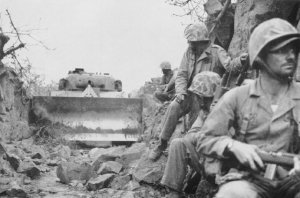
U.S. Marine Corps. Via ibiblio.org
Another important Sherman modification was the
tankdozer, a Sherman tank with a large bulldozer blade mounted on the
front of its chassis. This proved invaluable in battles in rough terrain, where the tankdozer could
plow a road for other tanks. The tankdozer could also pile rocks and
soil over cave mouths or fortifications, sealing in their occupants.
During the Iwo Jima campaign, a single Sherman was
field-modified with a flail like those used at Normandy in the European
conflict to clear minefields. This was a mixed success. It is likely
that flail tanks would
have been used in the invasion of the Japanese home islands, had the
invasion taken place.
Iwo Jima also marked the Pacific debut of the M17 launcher, a large mattress-like set of rocket launcher tubes mounted above the turret. This could put 640 pounds (290 kg) of explosives on a target in a single salvo. However, accuracy was poor.
Other modifications to the Sherman included versions with very heavy
armor; an assault gun version that replaced the 75mm gun with a 105mm
howitzer; and a version with a high-velocity 76mm gun capable of
penetrating 124mm of armor. The British Firefly Sherman also used a
76mm gun, but with an enhanced propellant charge
that gave it a penetration of 140mm of armor at close range. The more
heavily armed and armored variants likely did not see service in the
Pacific, where they were not needed against Japanese tanks, but the
assault gun version became a standard part of the TO&E of U.S. Army
tank battalions in 1944 .
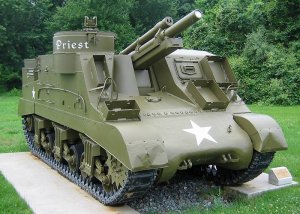
M7 Priest
The Sherman was supplemented by the M7B1 self-propelled gun, a 105mm howitzer mounted on a Sherman chassis. The gun was protected by an open-topped armored box (maximum 2" or 51mm) with a prominent commander's station that faintly resembled a pulpit, giving the vehicle its British nickname, "Priest." It had a maximum speed of about 24 mph (39 km/h). This self-propelled gun was much superior to the SPM and saw combat in the Pacific, beginning with the Kwajalein campaign.
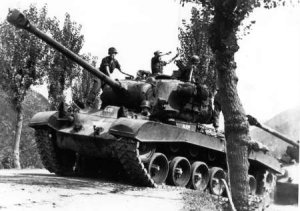
M26 Pershing
U.S. Army. Via Wikimedia
Commons
Had the Allies invaded Japan, they would likely
have employed the M26 Pershing heavy tank, which was armed with a
powerful 90mm gun, had 4" (102mm) of high-quality armor, and had a maximum
speed of 30
miles per hour. This excellent tank was a match for a German Panther
and would have completely outclassed anything in the Japanese arsenal.
American tanks were hindered by poor radios early
in the war. The earliest models in the Pacific, if they had a radio at
all, had a surplus GF-RU aircraft radio, an AM
radio that was noisy and could rarely be tuned to the sets of local
infantry units. By 1944 these had been replaced with SCR-508 or SCR-528
10-channel FM radios that were much better.
One of the challenges throughout the Pacific War was getting tanks ashore during an amphibious assault. The LST was designed specifically to bring up to 20 tanks ashore, but these ships were always precious and in short supply. The LCT could bring four tanks ashore, while the LCM could bring a single tank ashore. Starting with the Okinawa campaign, some medium tanks were rendered temporarily amphibious using the T-6 flotation kit, which consisted of six pontoons welded to the hull of the tank. The fore and aft pontoons were jettisoned using explosive bolts upon landing, while the side pontoons were permanently attached. The explosive bolts were roughly two inches by six inches (5cm by 15cm) and flew up to 200 feet (60m) when jettisoned, making them something of a hazard to nearby friendly infantry.
Commonwealth
Tanks. British
tank doctrine was based on a division of roles between cruiser and infantry tanks.
Infantry tanks were intended for direct infantry support. They were
relatively heavily armored to survive enemy fire, but they were not very
mobile. Cruiser tanks assumed the role of the cavalry, being light but speedy tanks that could quickly exploit breakthroughs.
The British discovered that the cruiser tanks could not stand up to
enemy antitank defenses, while improvements in tank engines allowed
infantry tanks to be designed with greater mobility, and the two types
gradually merged into a balanced design. This process was doubtless
helped along by the large numbers of Sherman tanks sent to Britain as
Lend-Lease.
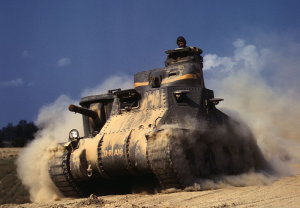
In addition to Sherman and Stuart tanks, the British received the M3 Lee, and this was employed in some numbers in Burma. The Lee was a quick improvisation rushed into production by the U.S. Army to fill the medium tank role until sufficient Shermans were available. It put a Stuart turret atop a rather high hull with a 75mm gun in a sponson in its the right front corner. Armor was a maximum of 51mm and early production was riveted rather than welded. Maximum speed was about 25 mph (40 km/h). Though inferior to the Sherman, the Lee was a match for any Japanese tank employed in Burma. However, it was vulnerable to a well-planned ambush, due to the restricted field of fire of the 75mm gun and the difficulty depressing the 37mm gun to hit targets at very close range.
The British also received the M7 Priest as Lend-Lease, and this self-propelled gun saw service at Meiktila and in the final drive on Rangoon.
Not all British tanks in the Far East were American Lend-Lease
models. The British allocated some of their own production of Valentine
tanks to 50 Armored Brigade in 1942. The
Valentine was an infantry tank that went through several models. Those
sent to the Far East were most likely the Mark III, the most common
model, which was armed with a 40m gun and 7.92mm coaxial machine gun, protected by up to 65mm of armor
and had a top speed of 15 mph (24 km/h). It was thus slow and
undergunned, though reasonably well protected. A total of 6855 of all models were produced.
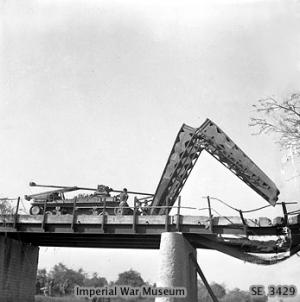
Imperial War Museum. Via Wikimedia Commons
The Valentine also came in a bridgelaying variant which replaced the
turret with a portable bridge for rapidly crossing demolished bridges
or unbridged ravines. This saw some use in 1945 in Burma.
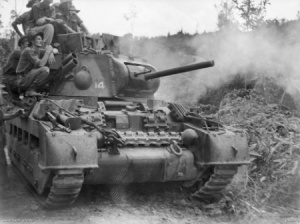
Imperial War
Museum. Via Wikimedia
Commons
Australian forces were equipped with a small number of the British Matilda II tank, which with 78mm armor but only a 40mm gun and a maximum speed of 15 miles per hour was reasonably well armored but badly undergunned and quite slow. The Australians equipped some Matildas with flamethrowers and also produced a tank bulldozer.
Russian Tanks. The Russian offensive in Manchuria in August 1945 was spearheaded by a large number of tanks, mostly T-34-85 medium tanks and JS-2 heavy tanks.
The T-34-85 was the ultimate development of the T-34, which proved
superior to German armor on the
Eastern Front in 1941 but was eventually outclassed by the German
Panthers and Tigers. It was nonetheless superior to anything slated for
use in the Pacific except the Russian's own JS-2 and the American M-26
Pershing. The T-34-85 had a maximum 2.4" (60mm) of armor, with the
armor unusually well sloped, and was armed with an 85mm gun capable of
penetrating 100mm of armor. It had a top speed of perhaps 30 miles per
hour (50 km/h).
The JS-2 had up to 6.3" (160mm) of armor, a 122mm gun capable of penetrating 160mm of armor, and a top speed of 23 mph (37 km/h). This was more armor than was needed against Japanese antitank weapons, and the armor piercing round was overkill against any Japanese tank. The JS-2's relative lack of mobility reduced its usefulness in the lightning Manchurian offensive. However, its powerful high explosive round was doubtless valuable against Japanese fortifications.
Chinese Tanks. The Chinese
began the war against Japan in 1937 with a handful of obsolete German
and Russian tanks. These were largely destroyed by the time war broke
out in the Pacific. Although the Kuomintang
received some obsolete U.S. scout cars in 1941, these were held in
reserve, and the Chinese did not field any armored forces until 1944.
In that year the Provisional
Tank Group went into battle in Burma
equipped with some older U.S. Shermans and Stuarts.
References
Gabel (1984, accessed 2012-2-10)
Gilbert (2001)
"Handbook on Japanese Military Forces" (1944-9; accessed 2011-8-21)
HistoryOfWar.org (accessed 2011-2-10)
"The Chinese Nationalist Armor in WWII" (accessed 2010-9-5)
U.S. Army TM9-759 (1942-8-4; accessed 2011-11-10)
WWIIVehicles.com
(accessed 2010-9-5)
The Pacific War Online Encyclopedia © 2007, 2009-2012 by Kent G. Budge. Index